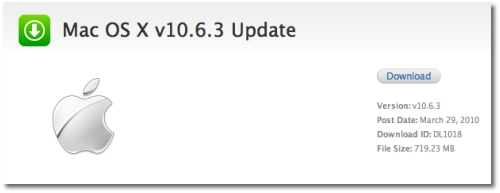

Fire up Software Update to get the download rolling, but only if you're cool with subjecting yourself to all sorts of unknown application breaks. You can check the full changelog after the break, but in all honesty, we're guessing that the unwritten change is integrated support for Intel's mobile Core i5 / Core i7 chips, both of which should become options on the MacBook Pro line as early as tomorrow last week.


Weighing in rather heavily at 757.3MB (when you upgrade from 10.6.2, anyway), this mammoth update brings along a laundry list of fixes, including improved reliability and compatibility of QuickTime X, a resolution to an issue that prevented files from copying to Windows file servers and boosted reliability of third-party USB input devices. OpenDNS helped us around a Twitter and Netflix outage back in 2016, but GoogleDNS didn't.Nearly five months after OS X 10.6.2 hit the pipes (and just seven months after 10.6.1), Apple has updated its Snow Leopard operating system to v10.6.3. Note that you may need to try more than one to get your sites working. Click on "Use the following DNS server addresses:" and type in one of the following public DNS server addresses:Ģ08.67.220.220 or 208.67.222.222 = OpenDNSĦ4.6.64.6 or 64.6.65.6 = VeriSign Public DNS.(If you use IPv6, change that one also/instead.) Left-click on Internet Protocol Version 4 (TCP/IPv4) and hit Properties.Right-click on your active network connection, then hit Properties.Hit Start and type Network Status (or right-click on your Wi-Fi icon and pick Open Network and Internet settings).OK, so how do I change my DNS on Windows? If you use a DNS server provided by a different company, they might record that info too.but at least it'll be harder for them to figure out who exactly is browsing those websites, which could make the data less valuable.Īnd at least one DNS provider has sworn it won't keep a log: CloudFlare (1.1.1.1) says it'll open itself up to third-party auditors to guarantee they aren't collecting data from you. That means they can easily see the websites you visit - and because they've got your name and address, too, they could theoretically build a fairly complete profile of you. How does a DNS server help with privacy?īy default, your computer probably reaches out to a DNS server controlled by your internet service provider (ISP), say Comcast or AT&T. it's like your computer no longer has GPS! But you can simply switch to another public DNS server to resolve those issues. The number, known as an IP address, is a far better description of where CNET actually lives. That server tells your web browser that "" actually means "203.36.226.2". To figure out the "driving directions," if you will, your computer contacts a special server (called DNS, for Domain Name System) to figure out the route. "" is just the street address of this website.


 0 kommentar(er)
0 kommentar(er)
